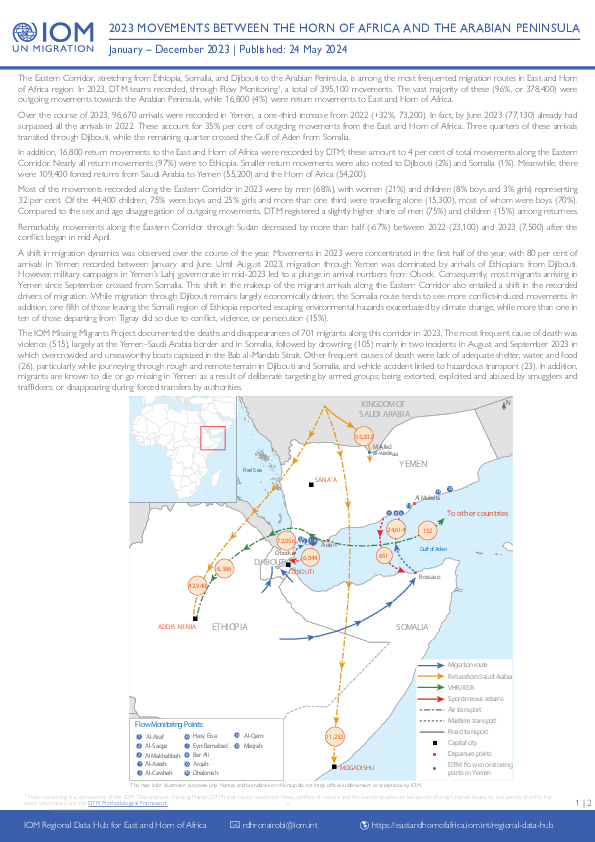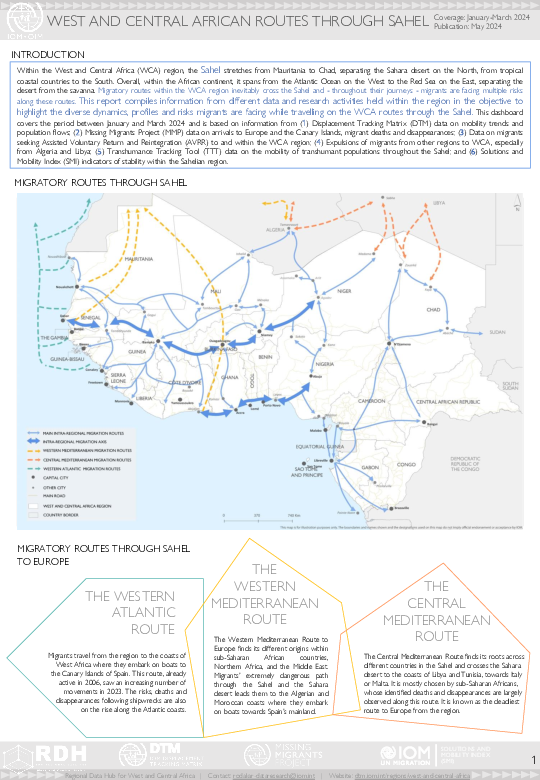-
Countries
-
Data and Analysis
-
Special Focus
-
Crisis Responses
Compilation/Overview
Color
white
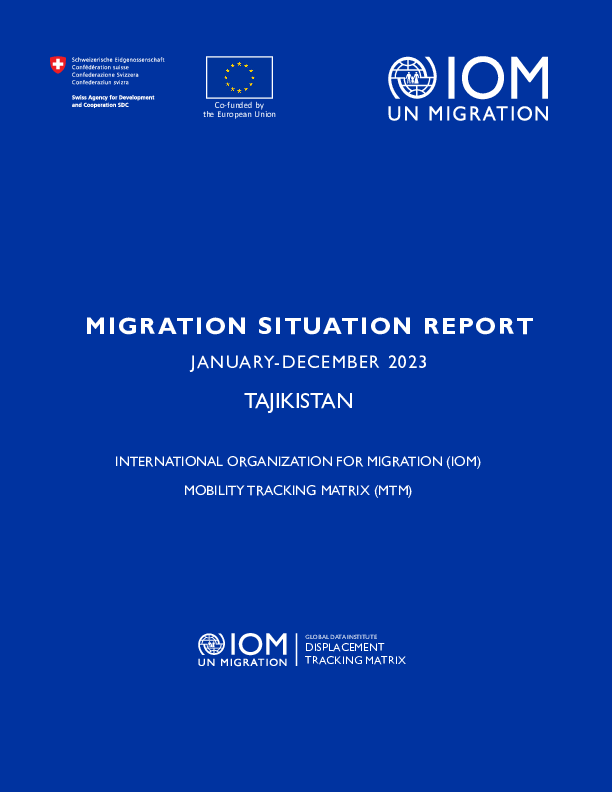
Contact
Contact mtmTajikistan@iom.int
Language
English
Location
Tajikistan
Period Covered
Jan 01 2023
Dec 31 2023
Activity
- Flow Monitoring
- Mobility Tracking
The report aims to provide an overview of the migration patterns and mobility in Tajikistan, drawing upon data from the latest available sources until the end of 2023 from national and international datasets on migratory movements concentrating on the most recent migration situation in Tajikistan. This includes migration flow, number of residences permits and remittances, as well as reasons for migration. The report includes the continuing impact of the Russian invasion of Ukraine on traditional migration corridors in the region, changing labour migration flows, increase of climate change and migration concerns, the growing urbanization process, the social-economic circumstances, and other major events are described as main contributing factors of the human mobility and migratory movements in the given period in the country.
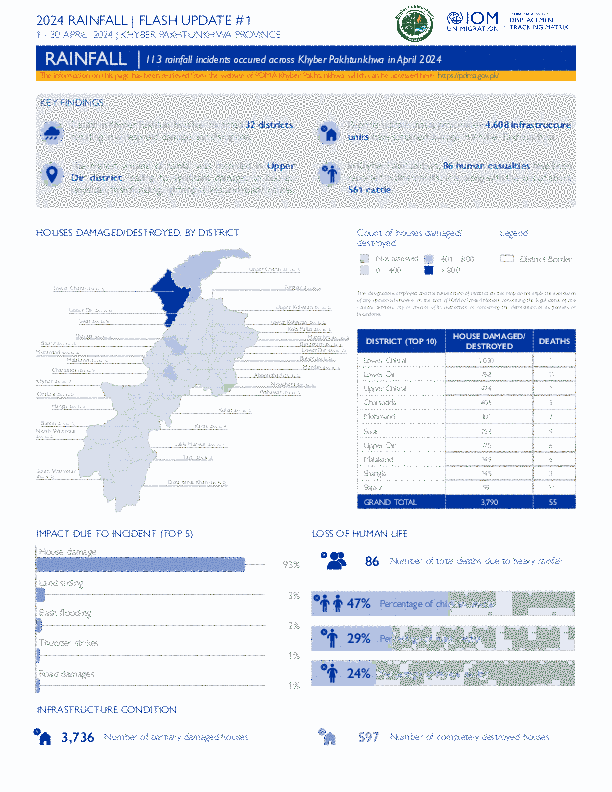
Contact
DTMPakistan@iom.int
Language
English
Location
Pakistan
Period Covered
Apr 01 2024
Apr 30 2024
Activity
- Event Tracking
Rainfall in Khyber Pakhtunkhwa has impacted 32 districts, resulting in widespread damage and disruption. Reports indicate that approximately 4,608 infrastructure units have sustained damage in Khyber Pakhtunkhwa. The highest volume of rainfall was recorded in Upper Dir district, leading to significant damages to houses, landslides, flash flooding, lightning strikes, and road closures. In Khyber Pakhtunkhwa, 86 human casualties have been reported in different districts, along with the loss of about 561 cattle.
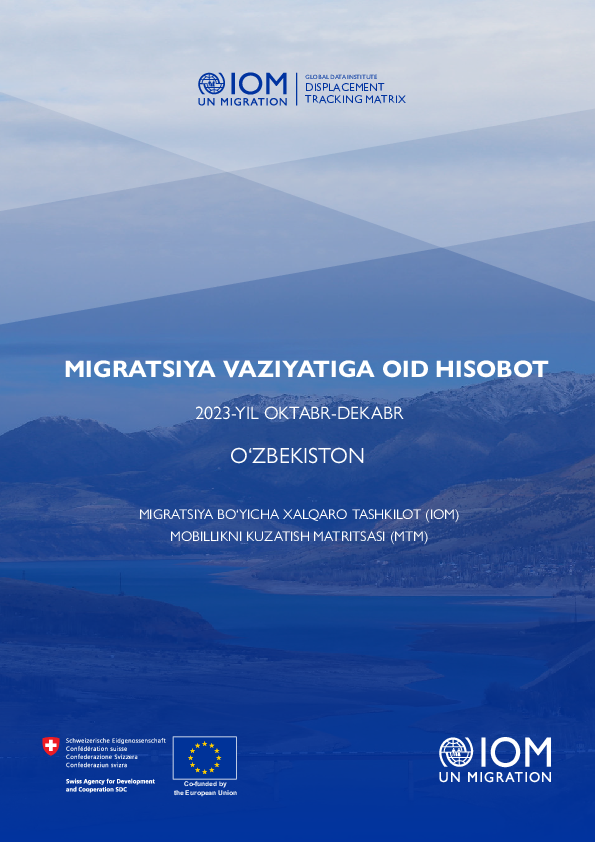
Contact
iomtashkent@iom.int
Language
English
Location
Uzbekistan
Period Covered
Oct 01 2023
Dec 31 2023
Activity
- Flow Monitoring Survey
- Mobility Tracking
Ushbu hisobot 2023-yil oktabr-dekabr oylari uchun mavjud ochiq maʼlumotlarga asoslanib, O‘zbekistondagi migratsiya muammolariga oid so‘nggi jarayonlar bo‘yicha maʼlumotlarni taqdim etadi hamda jamoatchilikka ochiq bo‘lgan milliy va xalqaro maʼlumotlar to‘plami asosida butun o‘tgan yil uchun migratsiya jarayonlariga oid asosiy xulosalarni keltiradi. Hisobot mamlakatdagi migratsiya vaziyatiga sezilarli ta’sir ko‘rsatgan so‘nggi yirik global va mintaqaviy voqealarni o‘z ichiga oladi. Rossiyaning Ukrainaga bosqini davom etishi hamda buning natijasida an’anaviy migratsiya yo‘laklari, mehnat migratsiyasi oqimining o‘zgarishi, iqlim o‘zgarishi va migratsiya xavotirlarining kuchayishi, o‘sib borayotgan urbanizatsiya jarayoni, ijtimoiy-iqtisodiy sharoitlar, tartibsiz migratsiya jarayonlarining kuchayishi va boshqa muhim voqealar mamlakatdagi ushbu davrda insonlar mobilligi va migratsiya harakatining asosiy omili sifatida tavsiflangan. Shuningdek, hisobot ushbu davrda O‘zbekistonda IOM tomonidan taqdim etilgan migratsiya ma’lumotlari bo‘yicha malaka oshirish sessiyalari haqida to‘xtalib, mazkur yo‘nalishdagi sa’yi-harakatlarni yoritadi.
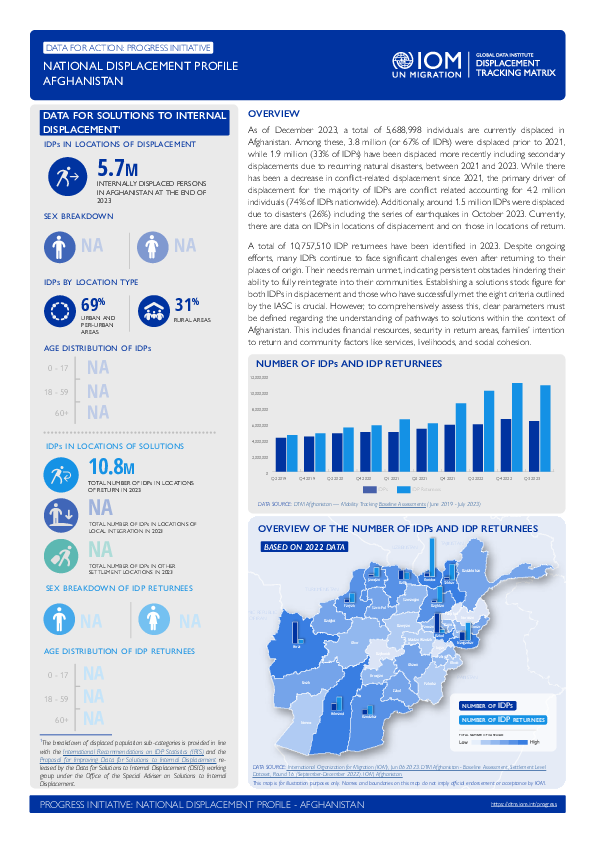
Contact
DTMAfghanistan@iom.int
Language
English
Location
Afghanistan
Period Covered
Jan 01 2023
Dec 31 2023
Activity
- Survey
- Displacement Solutions
Following the release of the first edition of PROGRESS 2023 report, the Displacement Tracking Matrix (DTM) has compiled a series of National Displacement Profiles based on end of year 2023 figures. These profiles offer insights into the latest end-of-year 2023 figures, aligning with the objectives outlined by the Data for Solutions to Internal Displacement Taskforce (DSID).
The profile provides a comprehensive overview of the demographic breakdowns and geographical distribution of internally displaced persons (IDPs) in Afghanistan as of the end of 2023. It delves into the primary areas of origin and displacement for IDPs, shedding light on the factors influencing their decision-making processes regarding the selection of solutions locations. Additionally, the report discusses the obstacles encountered by IDPs in their pursuit of durable solutions.
This compilation underscores the critical role of data in addressing internal displacement challenges and highlights the ongoing efforts to leverage data-driven solutions through collaborative initiatives like DSID.
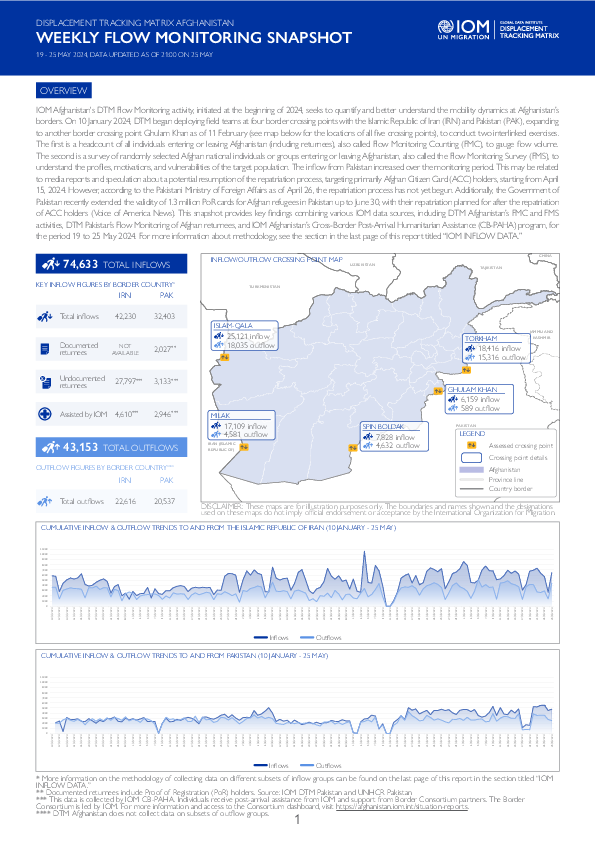
Contact
DTMAfghanistan@iom.int
Language
English
Location
Afghanistan
Period Covered
May 19 2024
May 25 2024
Activity
- Survey
- Flow Monitoring Survey
- Flow Monitoring
IOM Afghanistan's DTM Flow Monitoring activity, initiated at the beginning of 2024, seeks to quantify and better understand the mobility dynamics at Afghanistan’s borders. On 10 January 2024, DTM began deploying field teams at four border crossing points with the Islamic Republic of Iran (IRN) and Pakistan (PAK), expanding to another border crossing point Ghulam Khan as of 11 February (see map below for the locations of all five crossing points), to conduct two interlinked exercises. The first is a headcount of all individuals entering or leaving Afghanistan (including returnees), also called Flow Monitoring Counting (FMC), to gauge flow volume. The second is a survey of randomly selected Afghan national individuals or groups entering or leaving Afghanistan, also called the Flow Monitoring Survey (FMS), to understand the profiles, motivations, and vulnerabilities of the target population. The inflow from Pakistan increased over the monitoring period. This may be related to media reports and speculation about a potential resumption of the repatriation process, targeting primarily Afghan Citizen Card (ACC) holders, starting from April 15, 2024. However, according to the Pakistani Ministry of Foreign Affairs as of April 26, the repatriation process has not yet begun. Additionally, the Government of Pakistan recently extended the validity of 1.3 million PoR cards for Afghan refugees in Pakistan up to June 30, with their repatriation planned for after the repatriation of ACC holders (Voice of America News). This snapshot provides key findings combining various IOM data sources, including DTM Afghanistan’s FMC and FMS activities, DTM Pakistan’s Flow Monitoring of Afghan returnees, and IOM Afghanistan’s Cross-Border Post-Arrival Humanitarian Assistance (CB-PAHA) program, for the period 19 to 25 May 2024. For more information about methodology, see the section in the last page of this report titled “IOM INFLOW DATA.”

Contact
DTM Papua New Guinea, iompngmdac@iom.int
Language
English
Location
Papua New Guinea
Period Covered
May 29 2024
May 29 2024
Activity
- Mobility Tracking
- Baseline Assessment
A massive landslide occurred on the 24 May of 2024 at 3:00 AM local time in the southeastern area of Maip Muritaka Rural Local Level Government (LLG, Admin 3) in the Highlands´ Enga Province. The disaster caused extensive losses and damages to communities downhill, also destroying livelihoods and key infrastructure. The IOM team in coordination with the National Disaster Centre (NDC) implemented a DTM rapid assessment in a host community to provide relevant and timely information to humanitarian counterparts regarding the situation and main needs from the affected population.
This report presents initial findings from the round one of Mobility Tracking conducted at host communities in the Maip Muritaka Rural LLG from 25-27 May 2024. The two communities assessed reported a total of 7,849 individuals from 1,427 households affected, with 1,650 individuals from 315 households displaced. Population estimates from the National Statistics Office for 2021 indicate that the entire population of the Maip Muritaka Rural LLG is of some 26,450 inhabitants. By this numbers, the current disaster has affected at least 21% of the entire LLG population.
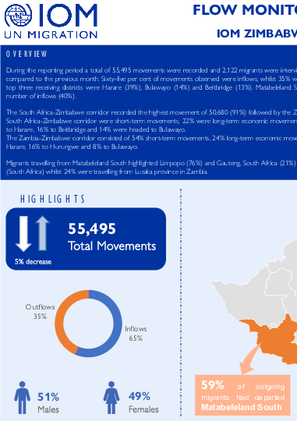
Contact
DTM Zimbabwe, DTMzimbabwe@iom.int, DTMsupport@iom.int
Language
English
Location
Zimbabwe
Period Covered
Apr 01 2024
Apr 30 2024
Activity
- Flow Monitoring
During the reporting period, a total of 55,495 movements were recorded and 2,122 migrants were interviewed across 20 Flow Monitoring Points (FMPs) in Zimbabwe. The total movements recorded decreased by 5% compared to the previous month. Sixty-five per cent of movements observed were inflows, whilst 35% were outflows. The top three sending districts were Beitbridge (59%), Harare (9%) and Chiredzi (9%), whilst the top three receiving districts were Harare (39%), Bulawayo (14%) and Beitbridge (13%). Matabeleland South province recorded the highest number of outflows (59%) whilst Harare province recorded the highest number of inflows (40%).
The South Africa-Zimbabwe corridor recorded the highest movement of 50,680 (91%) followed by the Zambia-Zimbabwe corridor which recorded 4,815 (9%) movements. Fifty-four per cent of movements along the South Africa-Zimbabwe corridor were short-term movements, 22% were long-term economic movements whilst 21% were family reunification movements. Of the migrants travelling from South Africa, 34% travelled to Harare, 16% to Beitbridge and 14% were headed to Bulawayo.
The Zambia-Zimbabwe corridor consisted of 54% short-term movements, 24% long-term economic movements and 21% family reunification movements. Of the migrants travelling from Zambia, 68% were travelling to Harare, 16% to Hurungwe and 8% to Bulawayo.
Migrants travelling from Matabeleland South highlighted Limpopo (76%) and Gauteng, South Africa (21%) as their intended destination. Of the incoming migrants travelling to Harare, 54% were travelling from Gauteng (South Africa) whilst 24% were travelling from Lusaka province in Zambia.
Over the course of 2023, 96,670 arrivals were recorded in Yemen, a one-third increase from 2022 (+32%, 73,200). In fact, by June 2023 (77,130) already had surpassed all the arrivals in 2022. These account for 35% per cent of outgoing movements from the East and Horn of Africa. Three quarters of these arrivals transited through Djibouti, while the remaining quarter crossed the Gulf of Aden from Somalia
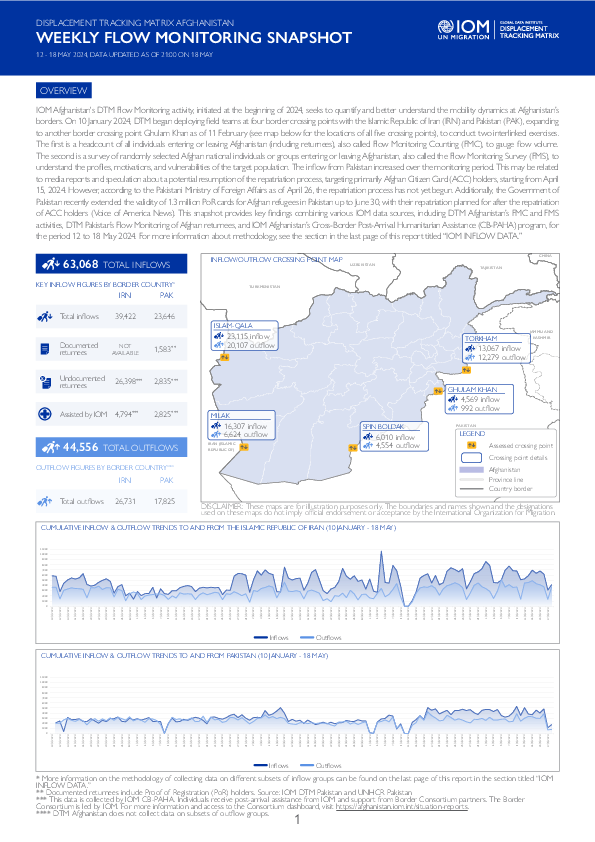
Contact
DTMAfghanistan@iom.int
Language
English
Location
Afghanistan
Period Covered
May 12 2024
May 18 2024
Activity
- Survey
- Flow Monitoring Survey
- Flow Monitoring
IOM Afghanistan's DTM Flow Monitoring activity, initiated at the beginning of 2024, seeks to quantify and better understand the mobility dynamics at Afghanistan’s borders. On 10 January 2024, DTM began deploying field teams at four border crossing points with the Islamic Republic of Iran (IRN) and Pakistan (PAK), expanding to another border crossing point Ghulam Khan as of 11 February (see map below for the locations of all five crossing points), to conduct two interlinked exercises. The first is a headcount of all individuals entering or leaving Afghanistan (including returnees), also called Flow Monitoring Counting (FMC), to gauge flow volume. The second is a survey of randomly selected Afghan national individuals or groups entering or leaving Afghanistan, also called the Flow Monitoring Survey (FMS), to understand the profiles, motivations, and vulnerabilities of the target population. The inflow from Pakistan increased over the monitoring period. This may be related to media reports and speculation about a potential resumption of the repatriation process, targeting primarily Afghan Citizen Card (ACC) holders, starting from April 15, 2024. However, according to the Pakistani Ministry of Foreign Affairs as of April 26, the repatriation process has not yet begun. Additionally, the Government of Pakistan recently extended the validity of 1.3 million PoR cards for Afghan refugees in Pakistan up to June 30, with their repatriation planned for after the repatriation of ACC holders (Voice of America News). This snapshot provides key findings combining various IOM data sources, including DTM Afghanistan’s FMC and FMS activities, DTM Pakistan’s Flow Monitoring of Afghan returnees, and IOM Afghanistan’s Cross-Border Post-Arrival Humanitarian Assistance (CB-PAHA) program, for the period 12 to 18 May 2024. For more information about methodology, see the section in the last page of this report titled “IOM INFLOW DATA.”
Within the West and Central Africa (WCA) region, the Sahel stretches from Mauritania to Chad, separating the Sahara desert on the North, from tropical coastal countries to the South. Overall, within the African continent, it spans from the Atlantic Ocean on the West to the Red Sea on the East, separating the desert from the savanna. Migratory routes within the WCA region inevitably cross the Sahel and - throughout their journeys - migrants are facing multiple risks along these routes.
This report compiles information from different data and research activities held within the region in the objective to highlight the diverse dynamics, profiles and risks migrants are facing while travelling on the WCA routes through the Sahel. This dashboard covers the period between January and March 2024 and is based on information from (1) Displacement Tracking Matrix (DTM) data on mobility trends and population flows; (2) Missing Migrants Project (MMP) data on arrivals to Europe and the Canary Islands, migrant deaths and disappearances; (3) Data on migrants seeking Assisted Voluntary Return and Reintegration (AVRR) to and within the WCA region; (4) Expulsions of migrants from other regions to WCA, especially from Algeria and Libya; (5) Transhumance Tracking Tool (TTT) data on the mobility of transhumant populations throughout the Sahel; and (6) Solutions and Mobility Index (SMI) indicators of stability within the Sahelian region.
Pagination
- Previous page
- Page 5
- Next page
